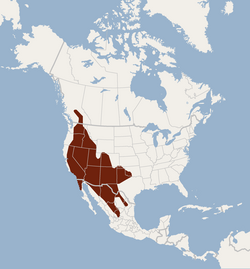| Dark-nosed small-footed myotis | |
|---|---|
| Scientific classification | |
| Kingdom: | Animalia |
| Phylum: | Chordata |
| Class: | Mammalia |
| Order: | Chiroptera |
| Family: | Vespertilionidae |
| Genus: | Myotis |
| Species: | M. melanorhinus |
| Binomial name | |
| Myotis melanorhinus Merriam, 1890 | |
 | |
The dark-nosed small-footed myotis (Myotis melanorhinus) is a species of mouse-eared bat in the family Vespertilionidae, described in 1890, and indigenous to Canada, Mexico, and the United States. [2] While the International Union for Conservation of Nature suggests that M. melanorhinus is uncommon, the species nonetheless enjoys an extensive habitat, at least encompassing British Columbia, central Mexico, and Oklahoma. [1]
